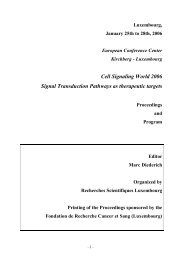Abstract book (download .pdf file) - Redox and Inflammation ...
Abstract book (download .pdf file) - Redox and Inflammation ...
Abstract book (download .pdf file) - Redox and Inflammation ...
Create successful ePaper yourself
Turn your PDF publications into a flip-book with our unique Google optimized e-Paper software.
Session 7: Cancer signaling networks Poster 4<br />
The inhibition of poly(ADP-ribosylation) affects cancer cell proliferation <strong>and</strong> telomere<br />
elongation<br />
Cristina Belgiovine, Francesca Donà, Ilaria Chiodi, Tatiana Raineri, Roberta Ricotti,<br />
Chiara Mondello <strong>and</strong> A. Ivana Scovassi<br />
Istituto di Genetica Molecolare CNR, Via Abbiategrasso 207, I-27100 Pavia, Italy<br />
belgiovine@igm.cnr.it<br />
Poly(ADP-ribosylation) plays a central role in Base Excision Repair (BER) <strong>and</strong> also in<br />
neoplastic transformation <strong>and</strong> telomere length regulation. It is catalyzed by a family of<br />
poly(ADP-ribose) polymerases (PARPs), of which the best characterized are PARP-1, PARP-<br />
2, TANK-1 <strong>and</strong> TANK-2, which convert NAD into ADP-ribose further used to form<br />
polymers. We investigated their expression levels during neoplastic transformation of cen3tel<br />
cells, which derive from human fibroblasts immortalized by ectopic hTERT expression <strong>and</strong>,<br />
during propagation in vitro, acquired the ability to grow in agar <strong>and</strong> subsequently to form<br />
tumors in nude mice. Upon further propagation, tumorigenic cells became more aggressive,<br />
showing a reduction in the time required to induce tumors; moreover, they reached telomere<br />
lengths >100 Kb <strong>and</strong> increased telomerase activity. We found a notable increase of PARP-1<br />
protein (<strong>and</strong> mRNA) in parallel to the acquisition of the tumorigenic potential; PARP-2 levels<br />
showed the same trend, while tankyrase expression did not show significant changes. As<br />
supported by poly(ADP-ribose) accumulation, overexpressed PARP-1 <strong>and</strong> -2 were very<br />
active, thus suggesting that poly(ADP-ribosylation) is modulated during neoplastic<br />
transformation <strong>and</strong> could be a target for contrasting tumor development. To address this point,<br />
we analyzed the effect of the known PARP inhibitor, 3-aminobenzamide (3-AB), on cell<br />
proliferation <strong>and</strong> telomere length. Increasing concentrations of 3-AB inhibited the<br />
proliferation of neoplastic cells in a dose-dependent manner. Remarkably, prolonged 3-AB<br />
administration to early tumorigenic cells also affected telomere length. On the whole, our data<br />
support an active involvement of poly(ADP-ribosylation) in neoplastic transformation <strong>and</strong><br />
telomere length maintenance. Thus, our work provides additional evidence in favor of the use<br />
of PARP inhibitors for the treatment of human cancer [Donà et al., Curr. Pharmaceut.<br />
Biotechnol. (2010), in press].<br />
141




